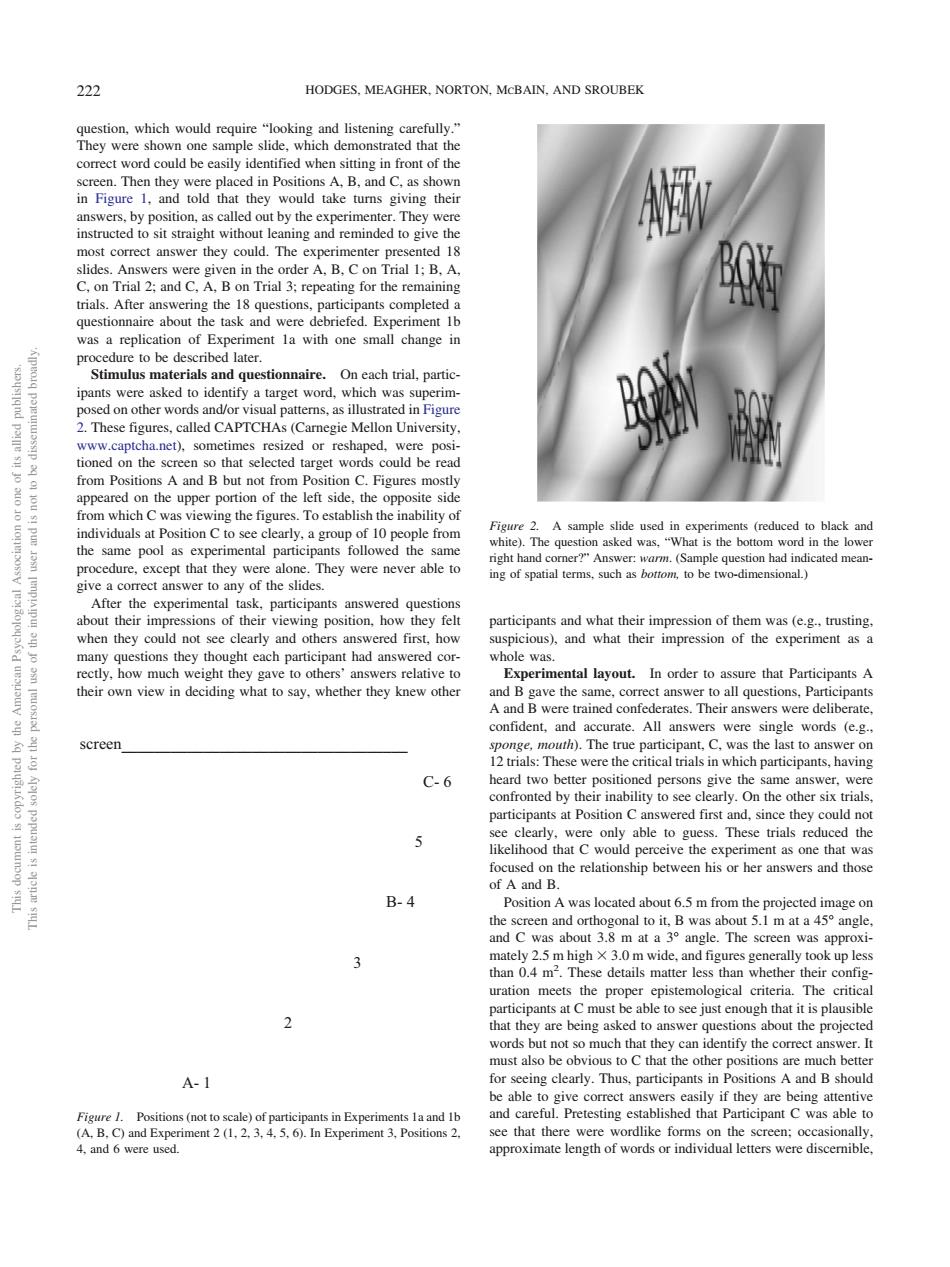正在加载图片...

222 HODGES.MEAGHER.NORTON.MCBAIN.AND SROUBEK ng in f of the cren.Then they were plac d in Positions A.B.and C.as shown The 橱 in the order A.B.C on Trial B.A. n Tri Bon Trial 3:repeating for the rema d ment lb oon of with one small change Stimulus materials and questionnaire. On each trial.partic .These figures.called CAPTCHAs (Camegie Mellon Un ersity d on the screen so that selected A and B which C wa nthe figur To establish th ility of igure 2 on C to se al n r”Ans ept that They were never able to ight red ut th ns of th ew g position.ho ions they th ght each participant had ans cor whole was ow muc tal layout. In order to sure that Particip dent,an ds (e C-6 participants C answered first nd.s they eive the iment as one that her answers and those B-4 uration meet pistemological criteria The critica vords but no dentify the correct answer.I A-1 clearly.Thu able to correct ereasily if they are】 approximate length of words or individual letters were discemiblequestion, which would require “looking and listening carefully.” They were shown one sample slide, which demonstrated that the correct word could be easily identified when sitting in front of the screen. Then they were placed in Positions A, B, and C, as shown in Figure 1, and told that they would take turns giving their answers, by position, as called out by the experimenter. They were instructed to sit straight without leaning and reminded to give the most correct answer they could. The experimenter presented 18 slides. Answers were given in the order A, B, C on Trial 1; B, A, C, on Trial 2; and C, A, B on Trial 3; repeating for the remaining trials. After answering the 18 questions, participants completed a questionnaire about the task and were debriefed. Experiment 1b was a replication of Experiment 1a with one small change in procedure to be described later. Stimulus materials and questionnaire. On each trial, participants were asked to identify a target word, which was superimposed on other words and/or visual patterns, as illustrated in Figure 2. These figures, called CAPTCHAs (Carnegie Mellon University, www.captcha.net), sometimes resized or reshaped, were positioned on the screen so that selected target words could be read from Positions A and B but not from Position C. Figures mostly appeared on the upper portion of the left side, the opposite side from which C was viewing the figures. To establish the inability of individuals at Position C to see clearly, a group of 10 people from the same pool as experimental participants followed the same procedure, except that they were alone. They were never able to give a correct answer to any of the slides. After the experimental task, participants answered questions about their impressions of their viewing position, how they felt when they could not see clearly and others answered first, how many questions they thought each participant had answered correctly, how much weight they gave to others’ answers relative to their own view in deciding what to say, whether they knew other participants and what their impression of them was (e.g., trusting, suspicious), and what their impression of the experiment as a whole was. Experimental layout. In order to assure that Participants A and B gave the same, correct answer to all questions, Participants A and B were trained confederates. Their answers were deliberate, confident, and accurate. All answers were single words (e.g., sponge, mouth). The true participant, C, was the last to answer on 12 trials: These were the critical trials in which participants, having heard two better positioned persons give the same answer, were confronted by their inability to see clearly. On the other six trials, participants at Position C answered first and, since they could not see clearly, were only able to guess. These trials reduced the likelihood that C would perceive the experiment as one that was focused on the relationship between his or her answers and those of A and B. Position A was located about 6.5 m from the projected image on the screen and orthogonal to it, B was about 5.1 m at a 45° angle, and C was about 3.8 m at a 3° angle. The screen was approximately 2.5 m high 3.0 m wide, and figures generally took up less than 0.4 m2 . These details matter less than whether their configuration meets the proper epistemological criteria. The critical participants at C must be able to see just enough that it is plausible that they are being asked to answer questions about the projected words but not so much that they can identify the correct answer. It must also be obvious to C that the other positions are much better for seeing clearly. Thus, participants in Positions A and B should be able to give correct answers easily if they are being attentive and careful. Pretesting established that Participant C was able to see that there were wordlike forms on the screen; occasionally, approximate length of words or individual letters were discernible, screen___________________________________ C- 6 5 B- 4 3 2 A- 1 Figure 1. Positions (not to scale) of participants in Experiments 1a and 1b (A, B, C) and Experiment 2 (1, 2, 3, 4, 5, 6). In Experiment 3, Positions 2, 4, and 6 were used. Figure 2. A sample slide used in experiments (reduced to black and white). The question asked was, “What is the bottom word in the lower right hand corner?” Answer: warm. (Sample question had indicated meaning of spatial terms, such as bottom, to be two-dimensional.) This document is copyrighted by the American Psychological Association or one of its allied publishers. This article is intended solely for the personal use of the individual user and is not to be disseminated broadly. 222 HODGES, MEAGHER, NORTON, MCBAIN, AND SROUBEK